45+ Incredibly Unique People That Will Make You Question Everything
16 May 2024Genetics often plays interesting tricks on us. It's capable of creating unique individuals with their peculiarities. Six fingers, overly dark skin color, elf-like ears... In our article, you can see a collection of unusual people that will surprise you.
1. The Melanin Goddess
Khoudia Diop, known as "The Melanin Goddess," hails from Senegal and works as a model. While many models are undeniably beautiful, what distinguishes her from others is her incredibly rich skin tone, brimming with melanin to such an extent that she has been hailed as a "Goddess of Melanin."
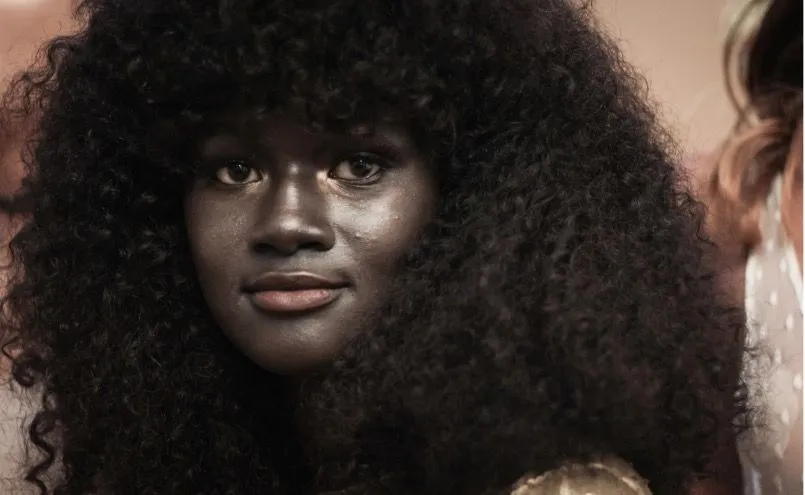 @How Khoudia Diop Learned To Love Her Dark Skin/kpbs.org
@How Khoudia Diop Learned To Love Her Dark Skin/kpbs.org
Despite such skin tones being common in Senegal, Diop endured bullying and criticism over her complexion during her childhood. However, the tide has turned, and she is now celebrated as one of the most renowned models on the global stage.
2. Elf-Like Appearance
Stef Sanjati, a YouTube personality, was born with a rare condition known as Waardenburg Syndrome. This genetic mutation results in wide-set eyes and heightens the risk of hearing impairment. This condition affects only 1 in every 40,000 individuals. Sanjati has admirably utilized her platform to raise awareness and educate others about this condition.
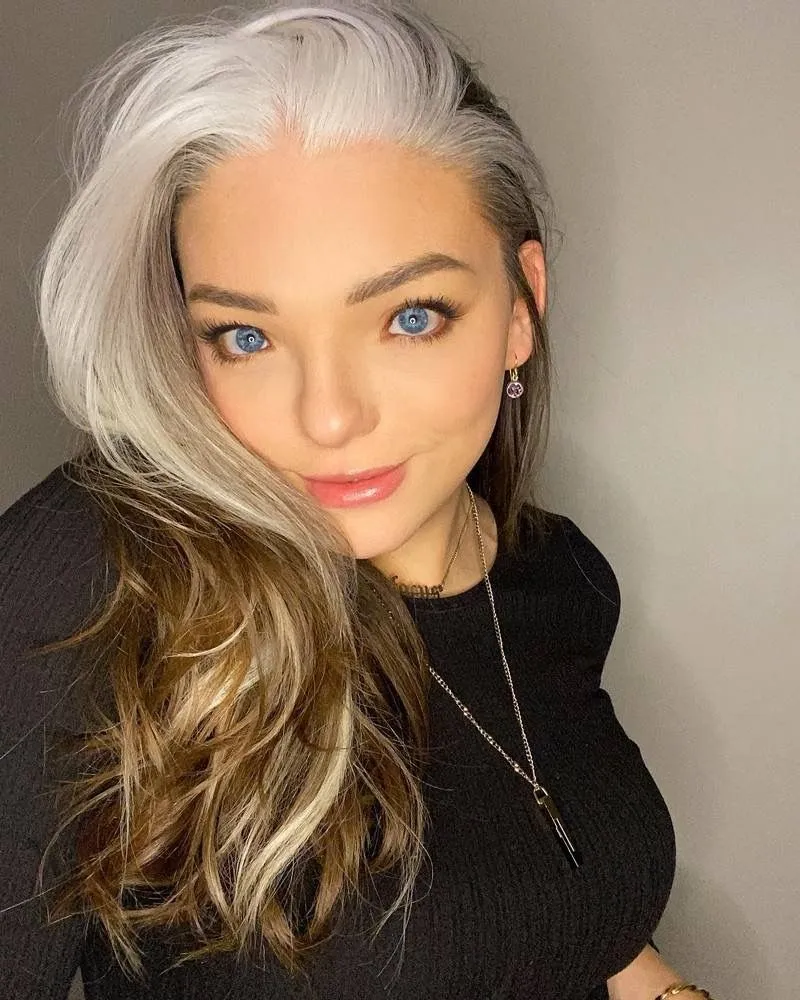 @Stef Sanjati/facebook.com
@Stef Sanjati/facebook.com
Sanjati's journey with Waardenburg Syndrome is not just about raising awareness; it's also a testament to resilience and self-acceptance. Despite facing challenges associated with her condition, such as potential hearing loss and societal misconceptions, she has embraced her unique features and turned them into a source of empowerment.
3. Uncomfortable Hair Syndrome
Shilah Madison, affectionately dubbed "The Little Lioness," was born with a condition that causes her hair to stand up continuously. While her mane-like appearance may resemble that of a lioness, it is known as "Uncomfortable Hair Syndrome".
 @Uncombable Hair Syndrome makes this child's mane almost impossible to brush/yahoo.com
@Uncombable Hair Syndrome makes this child's mane almost impossible to brush/yahoo.com
Her mother explains that the condition, is quite painful, often resulting in hair breakage from the roots. Despite the challenges posed by her rare condition, Madison remains as fearless as ever. It seems evident that she has wholeheartedly embraced her unique individuality.
4. The Cat-Eyed Boy
Nong Youhui, a young boy born in Southern China, possesses the extraordinary ability to see in the dark. This remarkable condition, known as Leukoderma, enables him to maintain clear vision both day and night. However, this unique gift comes with a drawback - his eyes are excessively sensitive to light.
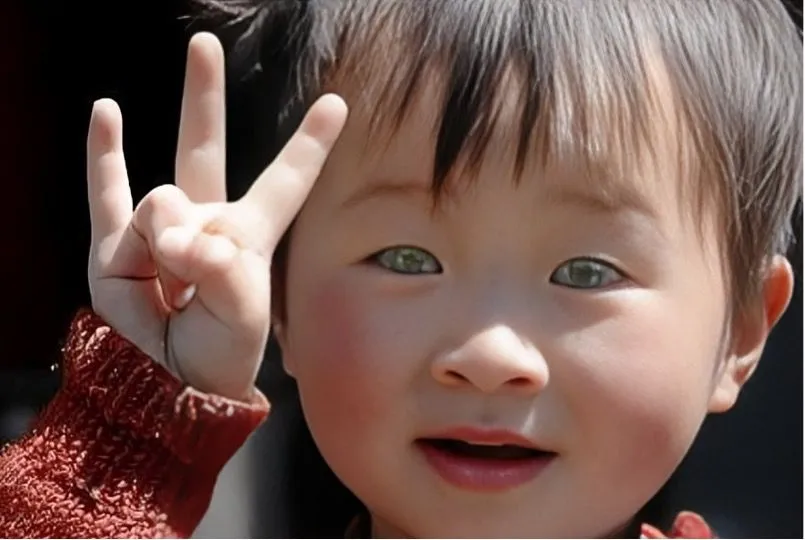 @HAB amoment/facebook.com
@HAB amoment/facebook.com
Despite the challenges posed by his heightened sensitivity to light, Youhui's remarkable ability to see in the dark has captivated many. His peers are often in awe of his unique gift, earning him the endearing nickname "cat-eye" among those who know him well.
5. The Woman with Pairs of Icy-Blue Eye
Jalicia Nightengale, known as "The Model with Ocean Eyes," possesses one of the most remarkable pairs of icy-blue eyes. Against her rich complexion, her blue eyes become even more striking, making her one of the most captivating figures in the modeling industry.
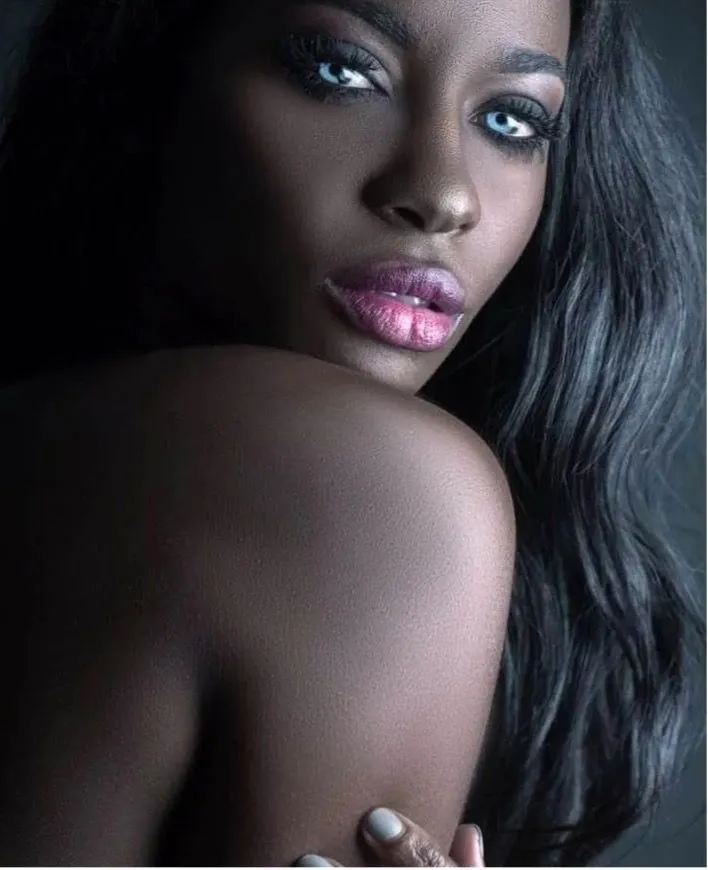 @Worldly_Werewolf_444/reddit.com
@Worldly_Werewolf_444/reddit.com
Like many others, Nightengale endured bullying during her upbringing due to her distinctive appearance. However, she eventually overcame the negativity and learned to embrace her uniqueness, developing a profound love for herself.
6. A Face that Displays Only Partial Pigmentation
Victoria Krus was born with vitiligo, a condition that uniquely affects only half of her face. Her case, known as "Unilateral Vitiligo," is remarkable in its asymmetrical manifestation. Like many others, Krus initially struggled to appreciate her appearance.
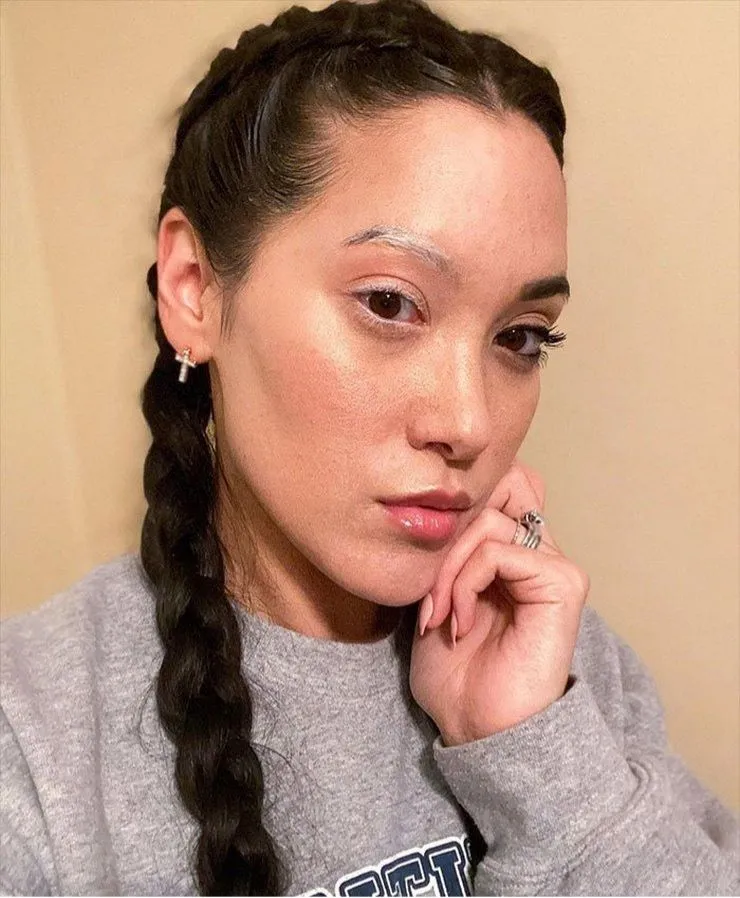 @Abhay Sinha/hindi.scoopwhoop.com
@Abhay Sinha/hindi.scoopwhoop.com
However, over time, she came to embrace her unique features and has since made a significant impact in the world of modeling. Through her success, she has not only shattered stereotypes but also inspired countless others to embrace their differences and celebrate their true selves.
7. People with Fused or Webbed Fingers
The notion of webbed fingers may seem like something out of a fictional story, but in reality, it's more common than one might think. Contrary to popular belief, approximately 1 in 2000 children are born with webbed fingers each year.
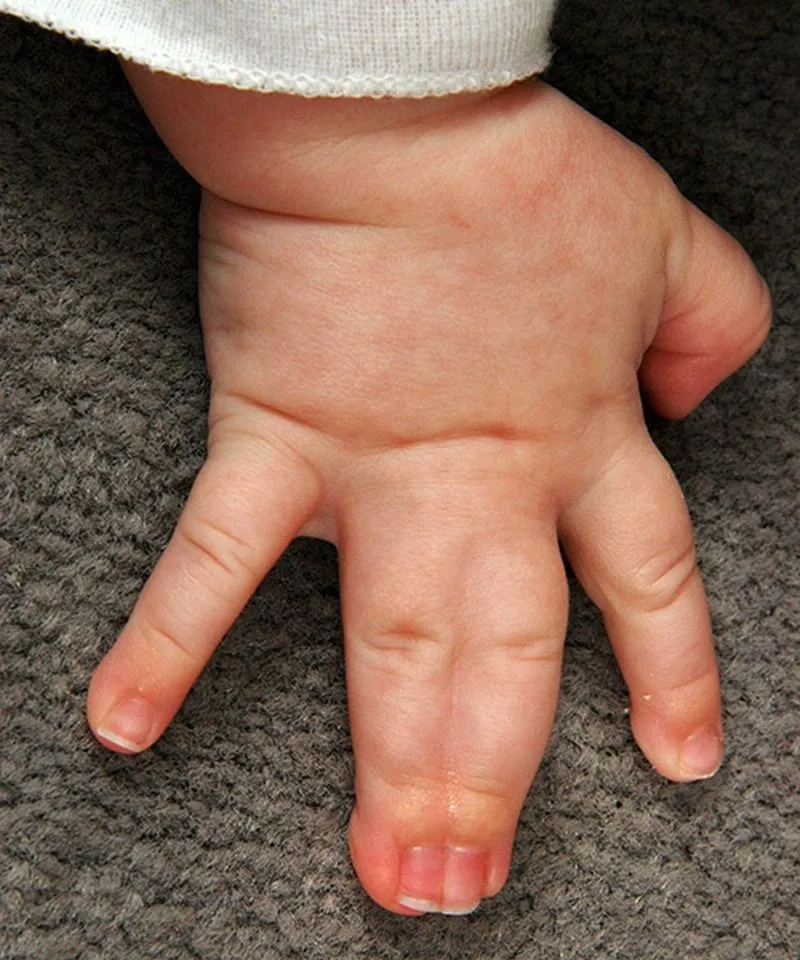 @IS SYNDACTYLY GENETIC?/nfsus.org
@IS SYNDACTYLY GENETIC?/nfsus.org
This condition, known as "Syndactyly," occurs when fingers fail to fully separate during fetal development, resulting in fused or webbed digits. While Syndactyly may vary in severity, it's a lot more prevalent than many people realize.
8. Springboards that Helped Build a Career
Hamad Jaman, the model whose freckles have become his signature feature. Like many, Jaman developed freckles during his childhood, but unlike others, his freckles continued to multiply over the years until they covered his entire face. While some speculate that sun exposure may have contributed to their spread.
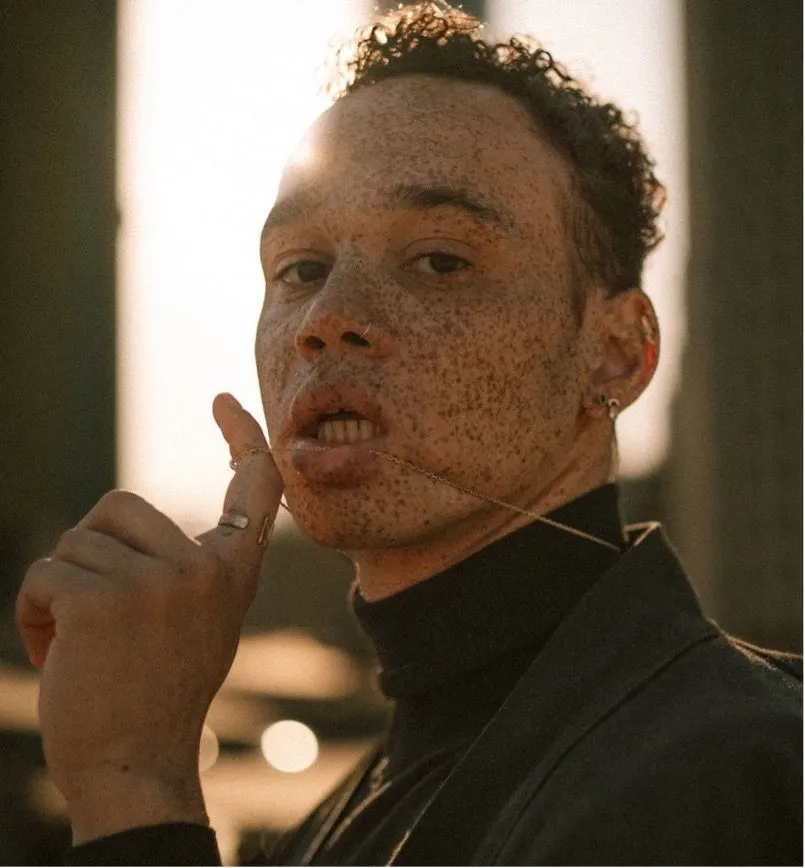 @Hamad Jaman/jadoremodels.co.uk
@Hamad Jaman/jadoremodels.co.uk
Regardless of the reason, Jaman's distinctive facial features have made him a striking presence in the modeling world. With his unique appearance, he effortlessly captivates attention and proves that true beauty lies in embracing one's individuality.
9. People who Have Superpowers
The wondrous abilities of individuals with hypermobility extend beyond mere flexibility. Their remarkable condition allows them to bend their hands all the way back, demonstrating unparalleled dexterity. But that's not all. They are remarkably special people.
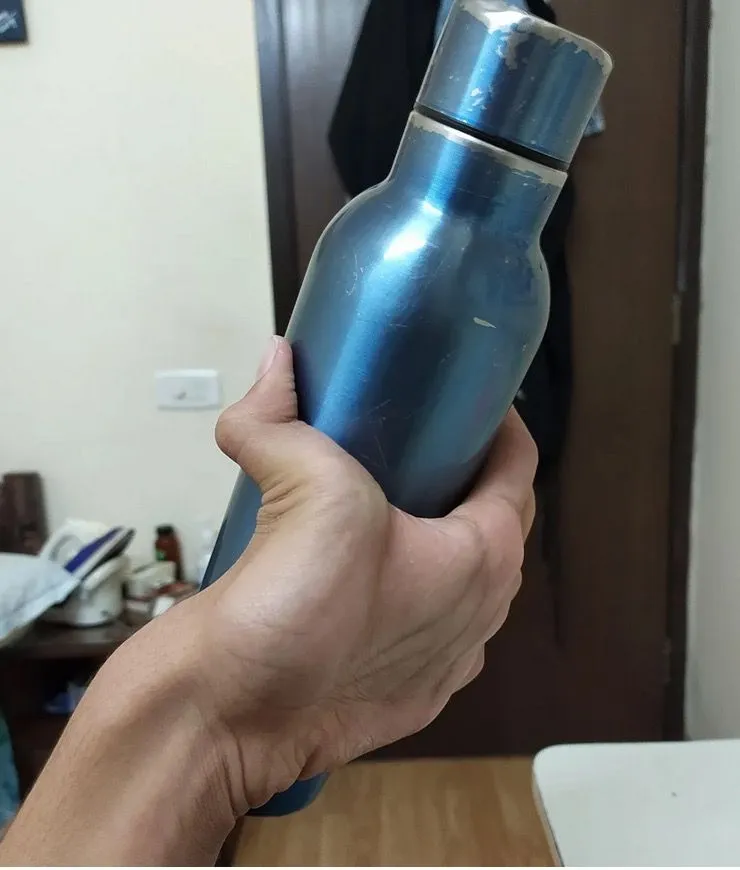 @SentientPotato42/reddit.com
@SentientPotato42/reddit.com
They possess the extraordinary capability to grasp objects even with their hands folded backward, showcasing a level of agility that is truly awe-inspiring. However, hypermobility is a rare phenomenon, with only 5% of the adult population worldwide experiencing this unique trait.
10. Breaking Gender Norms
Harnaam Kaur, an English activist born into a traditional Punjabi family, faces the challenges of polycystic ovary syndrome, which includes accelerated facial hair growth. Living within strict cultural beauty standards is already difficult, but with additional challenges like these, it can be particularly harsh.
 @Harnaam Kaur: Body positive activist with full beard becomes Guiness World Record holder/independent.co.uk
@Harnaam Kaur: Body positive activist with full beard becomes Guiness World Record holder/independent.co.uk
However, Kaur not only embraces these challenges but also becomes a prominent voice within the community, known for defying gender norms by growing a full beard. Embracing self-love wholeheartedly, she has become an inspiration for many worldwide.
11. The Mother and Daughter Share One Birthmark Between the Two of Them
Many of us carry a birthmark somewhere on our skin, a distinctive mark that sets us apart. However, for this mother and daughter duo, their connection runs deeper—they share a birthmark on their heads. This intriguing phenomenon is attributed to a DNA mutation known as Poliosis, which manifests as the absence of melanin on any hairy body part.
 @Bell_Ashley666/reddit.com
@Bell_Ashley666/reddit.com
Poliosis presents a striking contrast, often showcasing white or lighter-colored hair patches amidst darker strands. In the case of this family, the shared birthmark on their heads serves as a visible testament to their genetic connection. This condition can occur due to inheritance, passed down through generations, or it can arise from an autoimmune reaction.
12. A Person Has a Single Line Across the Palm
A single line stretching across the palm might seem like a simple feature, but for this individual, it's a mark of unique genetics. This distinctive trait, unlike the typical array of lines that form intricate patterns on the palm, stands out as a singular line, suggesting a genetic quirk that sets them apart.
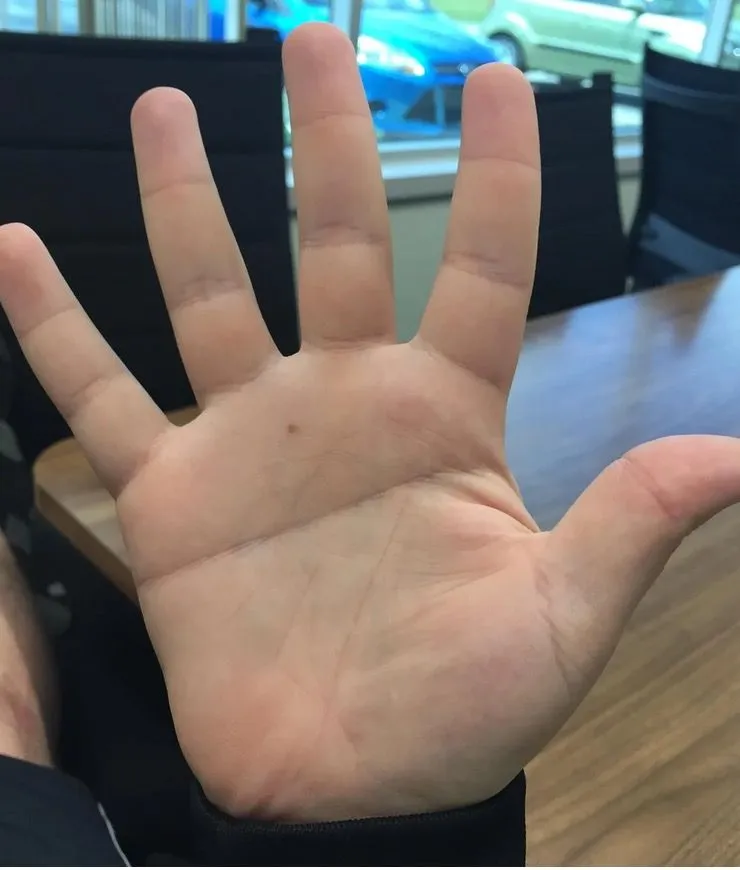 @[deleted]/reddit.com
@[deleted]/reddit.com
In palmistry, the study of palm lines and their meanings, each line is believed to carry significance, reflecting aspects of one's personality, life events, and even inherited traits. However, a solitary line spanning the width of the palm is rare and may signify something exceptional about the individual's genetic makeup.
13. “Spoon Nails” when the Fingernails to Grow Inverted
"Spoon nails," characterized by a concave shape resembling a spoon, serve as a visible reminder of the genetic journey traversed through generations. While the immunodeficient phase may pass, the nails retain their unique form, a testament to the intricate interplay between genetics and health.
 @TorchIt/reddit.com
@TorchIt/reddit.com
The changes to the FOXN1 gene were responsible for the primary immunodeficiency, leading to low T cells and complications with the thymus—an organ crucial for immune function. Remarkably, children typically outgrow the immunodeficient phase by the age of two, but the genetic fingerprint leaves a lasting mark.
14. Double Toes
During embryonic development, the formation of toes is a complex process orchestrated by the differentiation of specialized cells. However, in some instances, errors occur within these cells, resulting in variations in toe development. Polydactyly, a condition characterized by the presence of extra toes or fingers, is one such manifestation of these developmental anomalies.
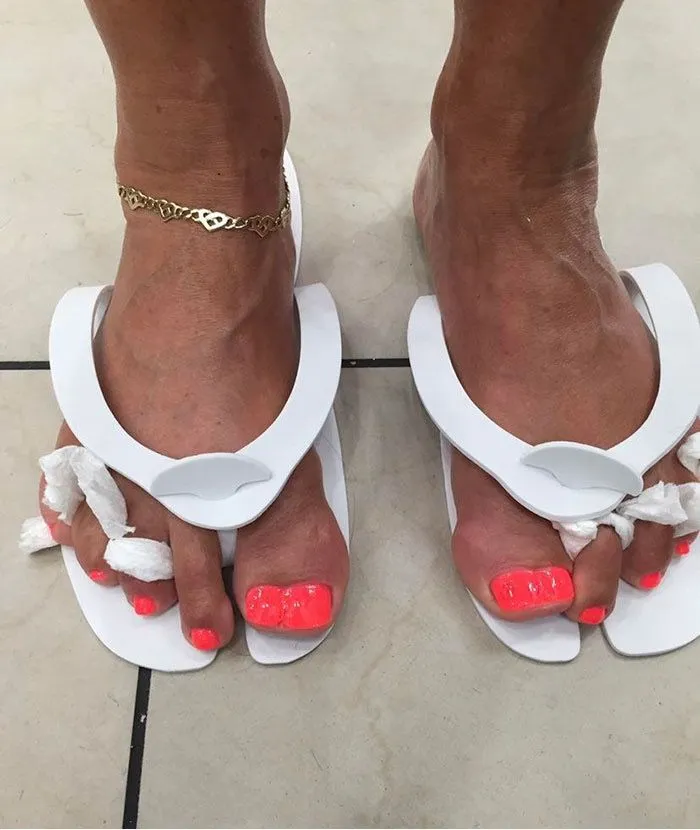 @gasp1324657980/reddit.com
@gasp1324657980/reddit.com
However, what distinguishes this particular presentation of polydactyly is the unique nature of the extra toes—they fail to fully separate. While some forms of polydactyly result in the emergence of a distinct and separate extra toe, in this instance, the additional toes remain connected, appearing as a fused digit.
15. The Woman was Born with Three Toes on Her Right Foot
The woman's life journey began with a unique twist in her genetic blueprint—a deviation that manifested in the form of three toes adorning her right foot instead of the customary five. This congenital anomaly falls under the umbrella of polydactyly, a category of deformities characterized by the presence of extra digits on the hands or feet.
 @darbel/reddit.com
@darbel/reddit.com
Polydactyly is rooted in genetics, often with a potential to echo through familial lines, although not in every instance. For some, it's a trait passed down from ancestors, a distinctive mark embedded within their genetic heritage. However, for others, it emerges as an isolated anomaly, a surprising deviation from the norm.
16. The Stripe on the Left Iris
The condition known as sectoral heterochromia casts a spell of fascination with its enchanting display of color variation within the iris of one eye. Unlike complete heterochromia, where each eye boasts distinctly different hues, sectoral heterochromia presents a captivating spectacle within a single iris.
 @CrazyQueen502Report/reddit.com
@CrazyQueen502Report/reddit.com
Here, a portion of the iris showcases a color that diverges from the dominant hue of the rest of the iris. Remarkably, sectoral heterochromia often emerges as a solitary anomaly, unaccompanied by significant symptoms or complications. While it may not impact vision or ocular health, its aesthetic allure is undeniable.
17. The Neck Skin is a Very Stretchy
Flexibility is a trait that varies widely among individuals, with some seeming to possess a natural suppleness from birth. Yet, for some, this flexibility extends beyond mere physical prowess and may be indicative of an underlying condition. Among these conditions is Ehlers-Danlos syndrome (EDS), a group of disorders that impact the skin, joints, and blood vessels.
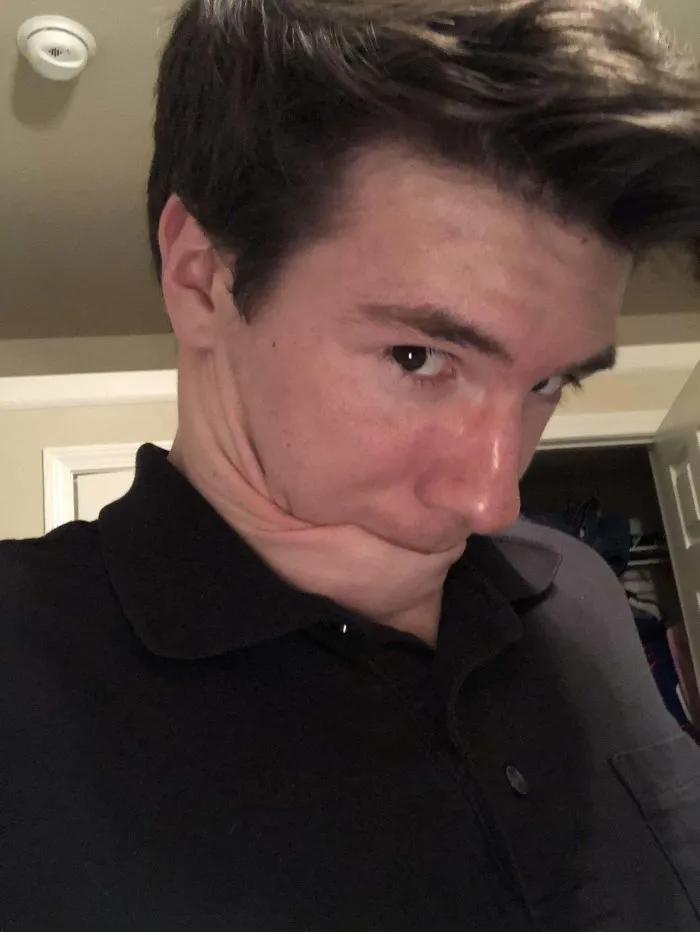 @Zen100_/reddit.com
@Zen100_/reddit.com
EDS presents a complex array of symptoms, but a hallmark feature is the excessive elasticity of the skin, which can stretch beyond what is considered typical. This heightened elasticity, while intriguing, comes with its own set of challenges. The skin, prone to stretching, may bruise easily, making it more susceptible to injury.
18. White and Numb Digit
The sensation of icy cold creeping into your fingers on a frosty winter day is a familiar experience for many. However, for some individuals, this chilling sensation doesn't dissipate with warmth but instead leaves their digits white and numb—a phenomenon often associated with Raynaud's disease.
 @Chimlerr/reddit.com
@Chimlerr/reddit.com
Raynaud's disease, a blood vessel disorder, manifests as a restricted blood flow to the extremities, particularly in response to cold temperatures or stress. When exposed to such triggers, blood vessels in the fingers and toes constrict excessively, limiting the amount of blood circulating to these areas. The result is a pallor or blanching of the affected digits, accompanied by numbness or tingling sensations.
19. A Thumb with Three Phalanges Instead of Two
Triphalangeal thumb (TPT) stands as a unique anomaly in the realm of congenital malformations, altering the traditional structure of the thumb by introducing a third phalanx where typically only two exist. This captivating deviation from the norm gives rise to a thumb that possesses an extra bone segment, distinguishing it from its conventional counterparts.
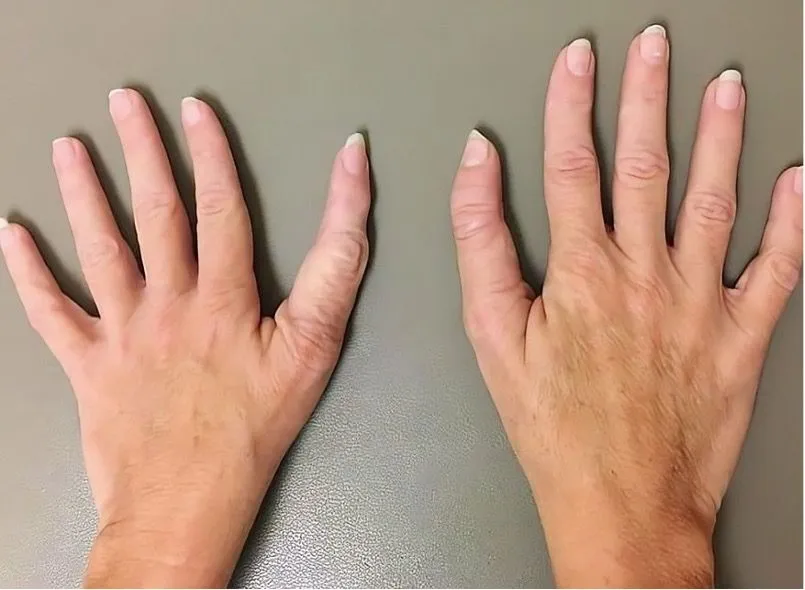 @Surgeox/reddit.com
@Surgeox/reddit.com
In TPT, the additional phalangeal bone assumes a range of sizes, adding a layer of complexity to the anomaly. While it may be as diminutive as a small pebble, resembling a mere protrusion, it can also expand to a size comparable to the phalanges found in the other digits of the hand.
20. The Eyelashes on One Eye
Judging a person's health solely from a single picture is a precarious task, often fraught with ambiguity. However, in some instances, certain visual cues may prompt speculation about underlying health conditions. Take, for example, the appearance of spot baldness, which bears a striking resemblance to a prevalent disorder known as alopecia.
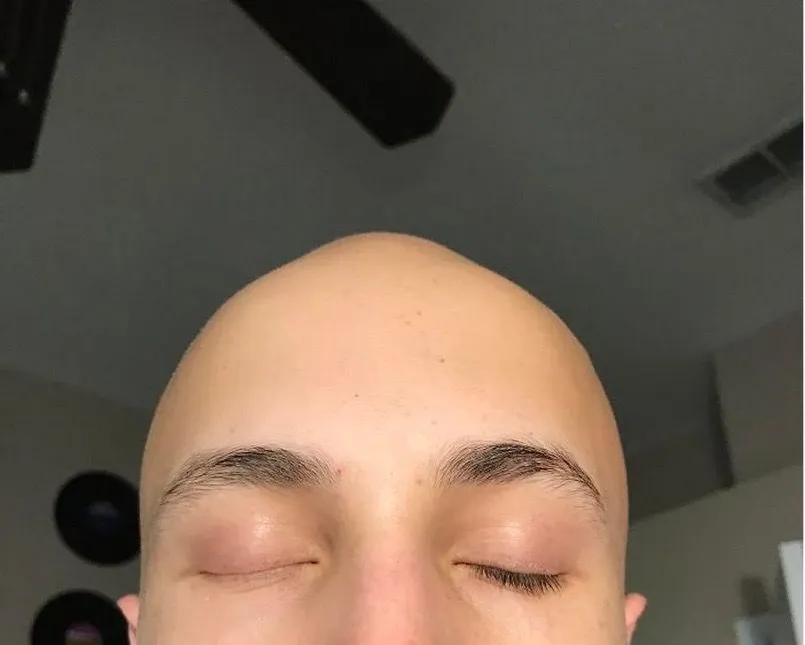 @benibensch/reddit.com
@benibensch/reddit.com
Alopecia, a common immune-mediated disease, manifests as patchy hair loss resulting from the immune system mistakenly attacking the hair follicles. While the severity and extent of hair loss vary from person to person, the hallmark of alopecia remains consistent—areas of baldness interspersed among areas of unaffected hair.
21. An Extra Hole in the Ear
While the sight of small holes in the ears may raise curiosity or concern, they're not necessarily indicative of a well-known condition. These peculiar features, known as preauricular pits, add an intriguing dimension to the landscape of human anatomy. Typically located at the front of the ear, closer to the face.
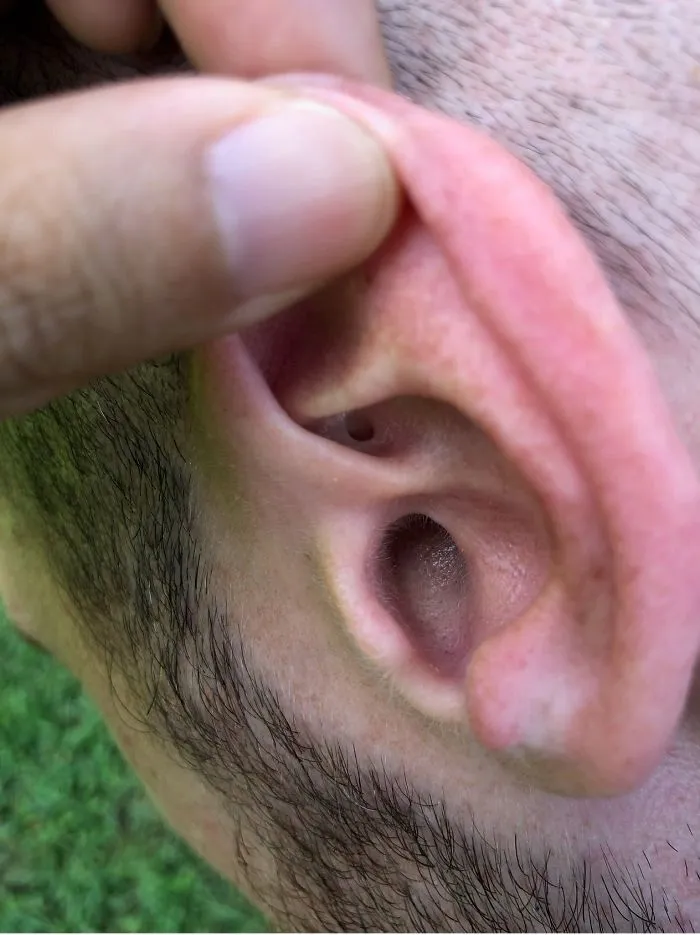 @dr3wzy10/reddit.com
@dr3wzy10/reddit.com
Preauricular pits are more than mere surface irregularities—they are connected to an unusual sinus tract beneath the skin, adding depth to their enigmatic nature. While in most instances, these pits remain innocuous and asymptomatic, for some individuals, they may pose a risk of infection.
22. The Way the Man's Knees Bend
Knee hyperextension, an occurrence where the knee joint is pushed beyond its natural range of motion, can have various causes and consequences. While the knee joint typically bends to about 180 degrees, certain activities, particularly those involving forceful impacts or repetitive stress on the joint, can lead to hyperextension.
 @joseycuervo/reddit.com
@joseycuervo/reddit.com
Athletes engaged in contact sports like soccer or football often find themselves at a heightened risk of knee hyperextension due to the frequent and forceful impacts sustained during gameplay. Over time, these impacts can cause the knee joint to extend further than its normal range, leading to instability and potential injury.
23. A Stripe Running Through It
Sectoral or partial heterochromia is a captivating anomaly that bestows a unique charm upon the eyes of those who possess it. Unlike the more common form of heterochromia, where each eye boasts distinctly different hues, sectoral heterochromia manifests as two completely different colors within a single iris.
 @russelljohnson13/reddit.com
@russelljohnson13/reddit.com
For most individuals born with sectoral heterochromia, the condition is benign, with no accompanying symptoms or complications. It simply serves as a delightful quirk of nature, enhancing the individual's appearance with its unconventional beauty.
24. Two Uvulas
The uvula, that peculiar piece of anatomy hanging at the back of the throat like a teardrop suspended in midair, plays a crucial role in oral and nasal function. Despite its small size, the uvula serves multiple important functions within the mouth, contributing to both speech and oral hygiene.
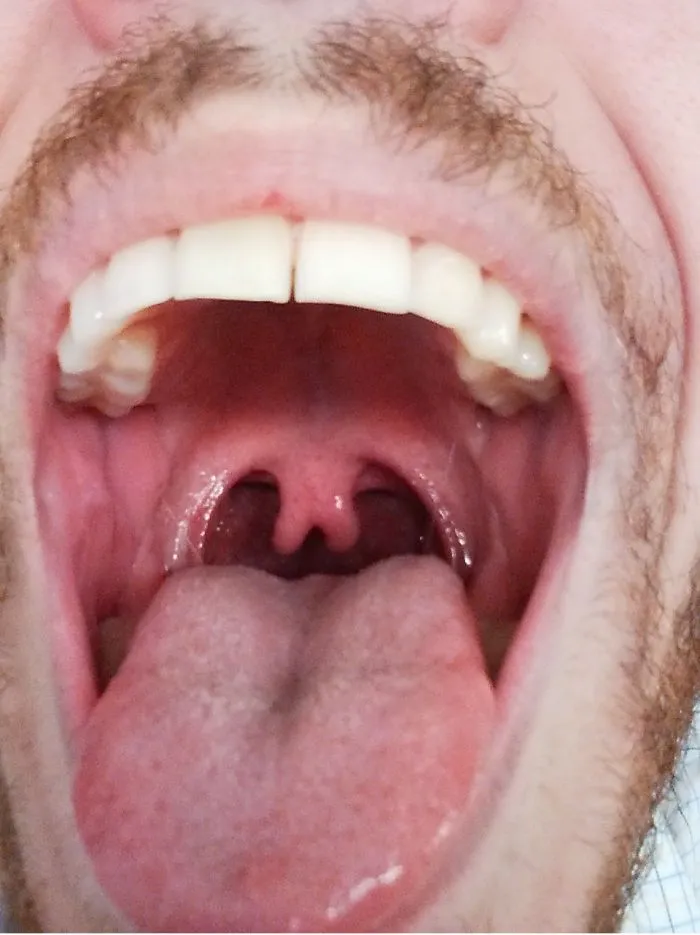 @TicoTube/reddit.com
@TicoTube/reddit.com
However, in some cases, the uvula may exhibit a variation known as bifid uvula or cleft uvula, characterized by a split or forked appearance. While this variation is typically non-harmful, it can sometimes lead to nasal-sounding speech and other mild symptoms.
25. An Iris Growing Over a Pupil
This individual is experiencing a condition known as a persistent pupillary membrane (PPM), characterized by the presence of a strand of tissue spanning the pupil. During fetal development, the pupillary membrane serves as a crucial source of blood supply for the lens. However, after birth, typically between the ages of 4 to 8 weeks, this membrane naturally regresses and dissipates.
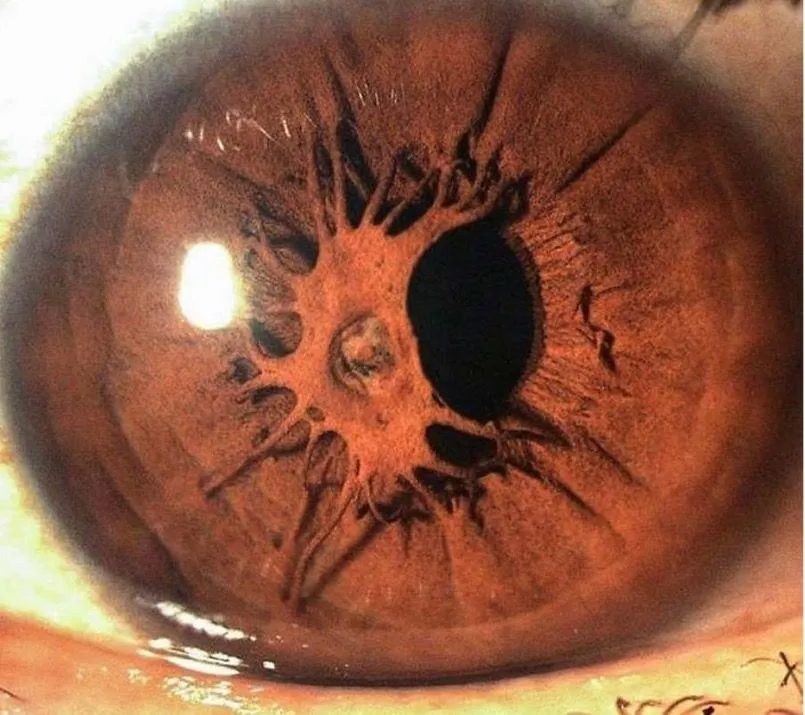 @alexioding/reddit.com
@alexioding/reddit.com
In most cases, a minimal amount of residual membrane tissue is considered harmless and does not impact vision. However, larger strands of tissue may potentially disrupt vision, necessitating further evaluation and management. Despite its potential to affect vision, persistent pupillary membrane is generally a benign condition.
26. This Peace Sign is Unusually Wide
When this man has been informed that his peace sign appears unusually wide, it raises questions about the flexibility of my joints, particularly regarding their hypermobility. To evaluate this, healthcare professionals often employ the Beighton scoring system, which assesses the flexibility of various joints in the body using a 9-point scale.
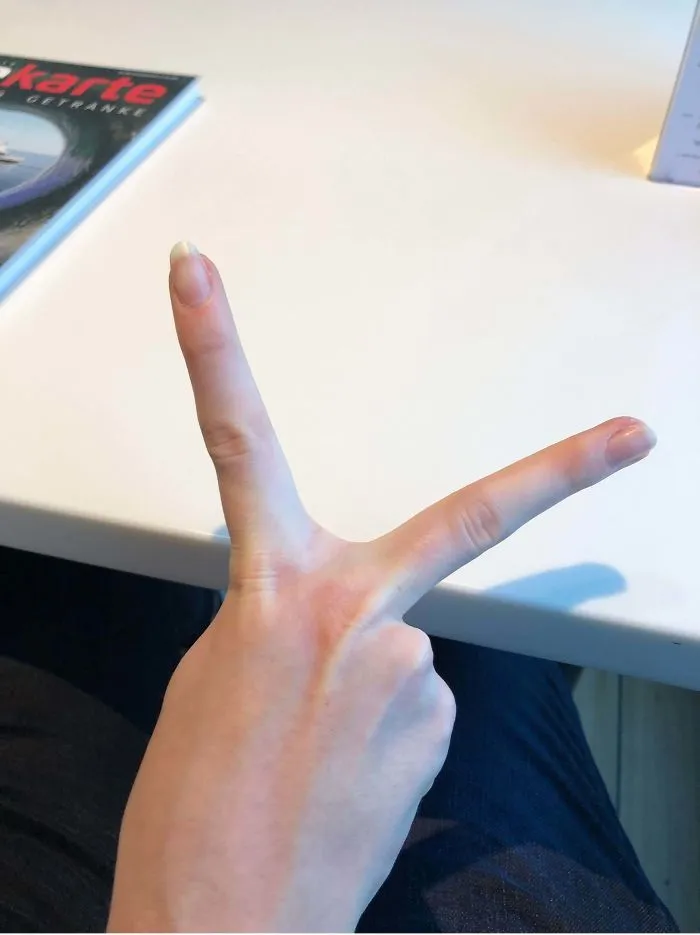 @Paulpr0/reddit.com
@Paulpr0/reddit.com
The assessment involves measuring the fingers, elbows, knees, and spine for their range of motion. For example, to test finger flexibility, one would place the palm and forearm on a surface with the palm side down and fingers extended. Then, attempt to lift and bend the fifth finger at the knuckle beyond 90 degrees.
27. When the Ring and Middle Fingers are Connected
This situation may suggest a case of simple syndactyly, a medical condition characterized by webbed or conjoined fingers and toes. Syndactyly ranks among the most prevalent malformations, affecting approximately 1 in every 2,000 to 3,000 children annually.
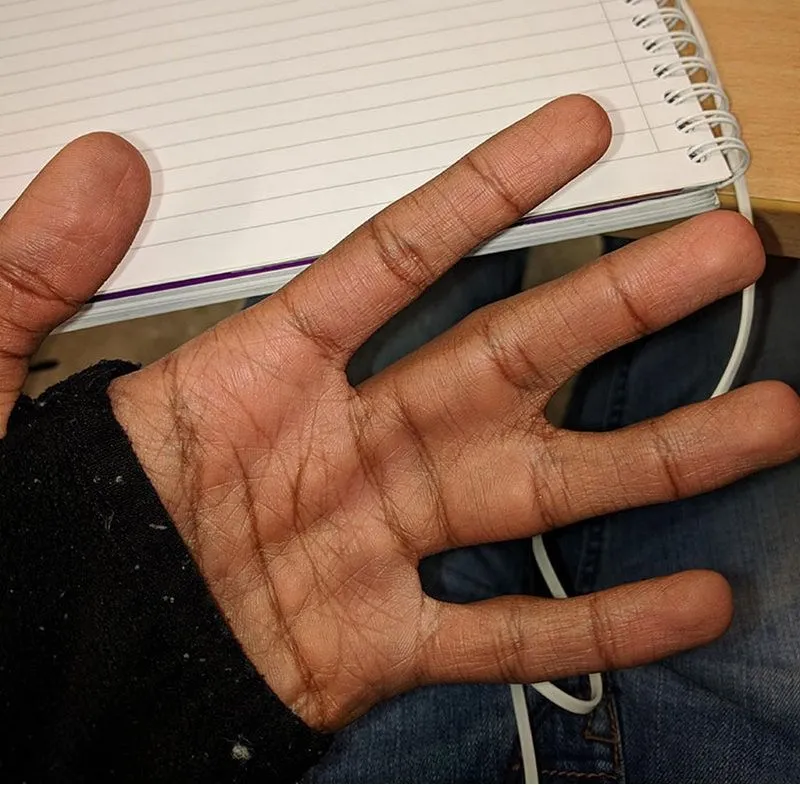 @NTOOOO/reddit.com
@NTOOOO/reddit.com
Syndactyly typically occurs during fetal development, specifically between the 7th and 8th weeks of gestation. During this critical period, fingers and toes undergo a process of separation, but in cases of syndactyly, this separation is incomplete, resulting in fused digits.
28. Albinism Affecting the Eyes
Ocular albinism is a genetic condition characterized by a lack of pigment in the eyes, specifically in the retina, choroid, and iris. This absence of pigment can lead to various eye-related issues, such as reduced visual acuity, sensitivity to light (photophobia), and involuntary eye movements (nystagmus).
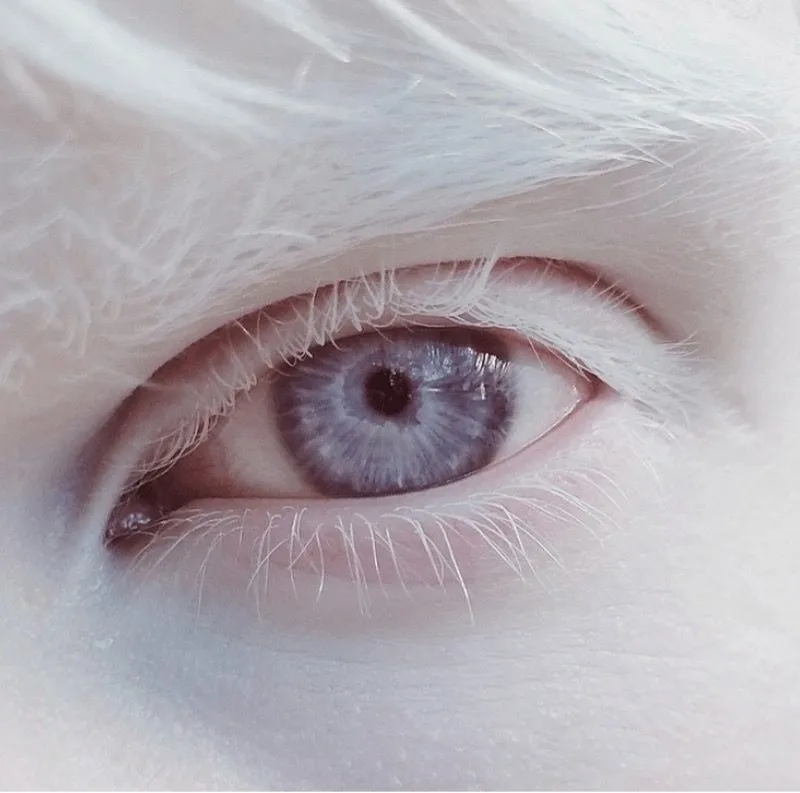 @What is Albinism?/zoomax.com
@What is Albinism?/zoomax.com
Unlike other forms of albinism that affect the entire body, ocular albinism primarily impacts the eyes while leaving the skin and hair color relatively unaffected. This makes it distinct from oculocutaneous albinism, where pigment is lacking in both the skin and eyes.
29. The Thumb is a Bit Too Big
In recent times, the prevalence of overworked digits, particularly in the context of smartphone usage, has surged. The repetitive motions associated with constant smartphone use, such as typing, swiping, and scrolling, can exert significant strain on the muscles and tendons of the fingers and thumbs.
 @BeardedGlass/reddit.com
@BeardedGlass/reddit.com
Surprisingly, this prolonged and repetitive thumb activity can lead to noticeable physical changes. Hand therapist Nicola Goldsmith explains that frequent thumb swiping, in particular, can contribute to an increase in muscle length and bulk in the thumb muscles. As a result, individuals may observe localized changes in the size and appearance of their thumbs.
30. The Internal Bruising in the Finger
The sight of internal bruising visible through the skin when holding a hand up to the light is indeed intriguing. This phenomenon captivated many individuals when a picture showcasing it was shared on Reddit. However, what puzzled observers even more was the apparent absence of finger bones in the image.
 @Enceladus89/reddit.com
@Enceladus89/reddit.com
The reason for this curious optical illusion lies in the properties of the skin and flesh. When light passes through these tissues, it becomes diffused and scattered, much like looking through a frosted glass pane. This diffusion effect is amplified in the case of internal bruising, as the presence of blood and tissue damage further alters the passage of light.
31. Abnormal Wrinkly Hands
Abnormal wrinkly hands, characterized by excessive or premature wrinkling of the skin, can be a source of concern and curiosity for many individuals. While some degree of wrinkling is a natural part of aging, certain factors can contribute to the development of more pronounced or premature wrinkles on the hands.
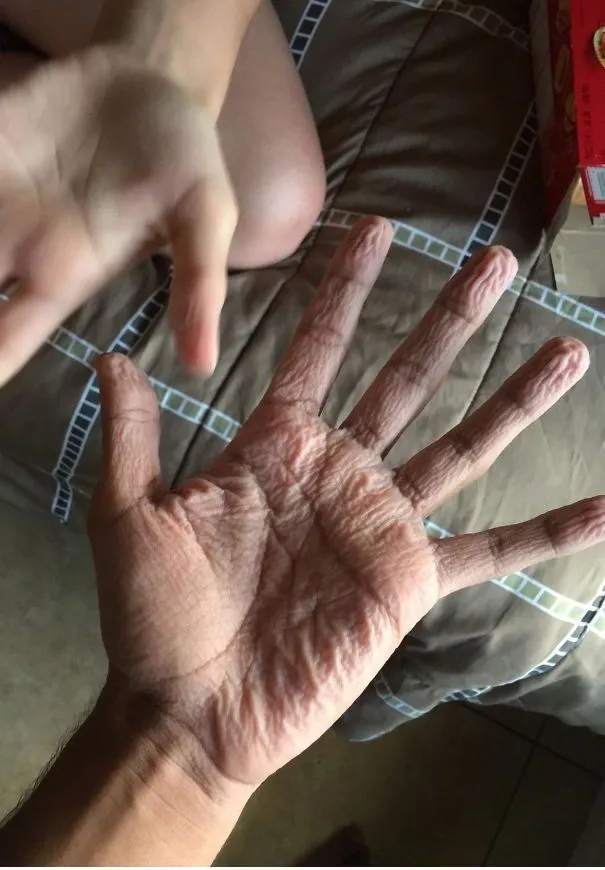 @aliens-dope/reddit.com
@aliens-dope/reddit.com
One common culprit behind abnormal wrinkly hands is excessive sun exposure. The ultraviolet (UV) rays from the sun can accelerate the breakdown of collagen and elastin fibers in the skin, leading to premature aging and the formation of wrinkles. Since the skin on the hands is often exposed to sunlight without adequate protection, it is particularly vulnerable to UV damage.
32. The Boy with Coloboma in Both Eyes
Coloboma is a congenital eye abnormality that typically manifests before birth, and during fetal development. This condition is characterized by the absence of tissue inside certain structures of the eye, resulting in distinct anatomical features. One notable characteristic of coloboma is the "key-hole" appearance of the pupil, which may give the affected eye a unique and recognizable appearance.
 @Taylor_Satine/reddit.com
@Taylor_Satine/reddit.com
Despite the striking appearance of the eye, it's important to note that coloboma does not necessarily lead to vision loss. In many cases, individuals with coloboma have normal or near-normal vision, as the condition primarily affects the appearance of the eye rather than its function.
33. Number 2 on the Head
Birthmarks, with their enigmatic shapes and patterns etched into the skin, have long sparked fascination and inspired myths, legends, and folklore across cultures. These unique markings serve as a canvas for imagination, inviting interpretations that range from the mystical to the mundane.
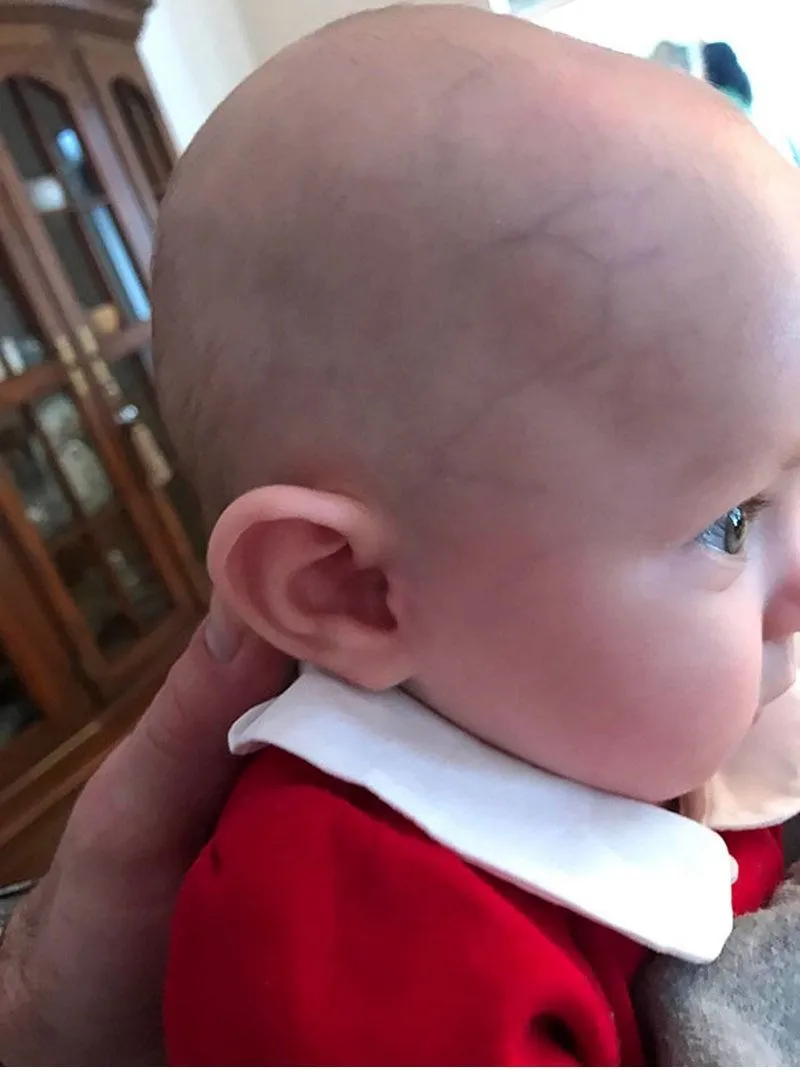 @JoumanaKayrouz/reddit.com
@JoumanaKayrouz/reddit.com
In the case of one baby, adorned with a particularly unusual birthmark, her parents playfully speculated on its meaning. As they joked, being their first child, perhaps the number "2" etched into her skin hinted at a compelling narrative—that she was meant to have had a twin, who mysteriously vanished, absorbed by her in the womb.
34. He was Born Without a Bridge in his Nose
The nasal bridge, a saddle-shaped area encompassing the nasal root and the lateral aspects of the nose, is a prominent feature of the face. However, in some cases, individuals may present with what is known as a depressed nasal bridge, where this region appears flattened or indented. This distinctive characteristic can arise from various conditions, both congenital and acquired.
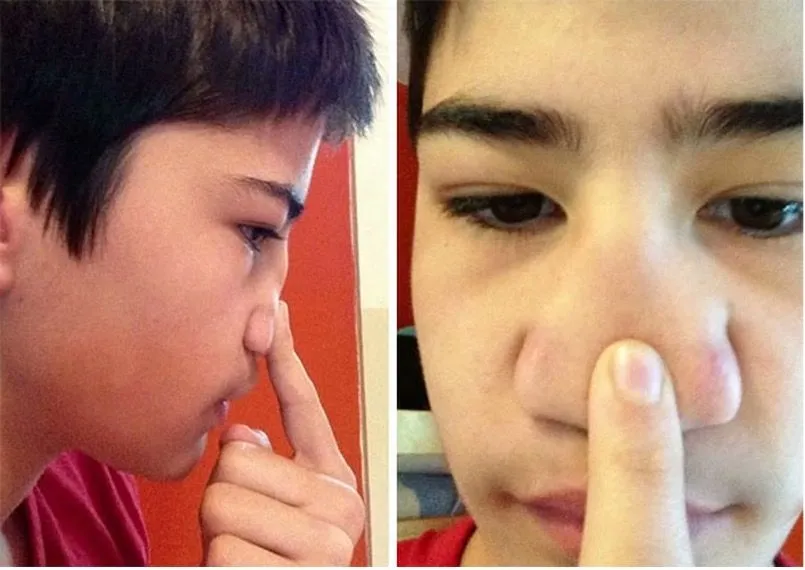 @fedorahitler/reddit.com
@fedorahitler/reddit.com
In pediatric orthopedic practice, several congenital syndromes are commonly associated with a depressed nasal bridge. These include cleidocranial dysplasia, neurodevelopmental delay, etc. Each of these syndromes presents its own set of unique challenges and medical considerations, but a depressed nasal bridge is often a characteristic feature shared among them.
35. The Woman was Born with 6 Toes and Her Co-Worker Was Born With 4 Toes
Six toes, a condition known as hexadactyly, is a relatively common birth defect characterized by the presence of an additional digit on the foot. The term "hexadactyly" itself translates to "six digits," reflecting the anomaly of having more than the typical five toes.
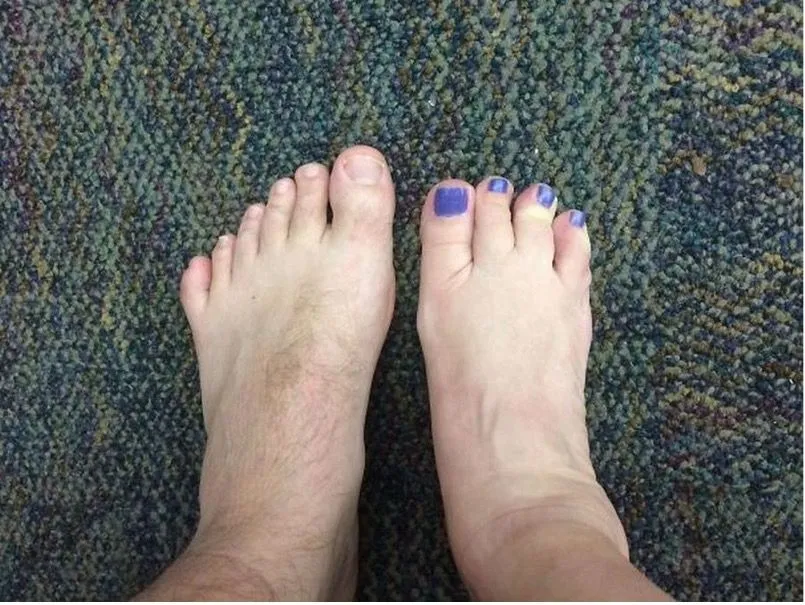 @DomnLee/reddit.com
@DomnLee/reddit.com
This additional toe can manifest in various locations on the foot, including on the side of the toes or in between existing digits. While the presence of extra toes may initially raise concerns, it's important to note that in many cases, hexadactyly is harmless and does not cause significant functional impairment.
36. Tentacles under the Tongue
No, this isn't an intricate Halloween prop; it's a real anatomical feature known as fimbriated folds of the tongue or plica fimbriate. These peculiar tentacle-like flaps emerge from the folds that run alongside the frenulum, the tissue linking the tongue to the bottom of the mouth. When these folds develop small growths or skin tags, they give rise to these distinctive structures.
 @SligPants/reddit.com
@SligPants/reddit.com
Despite their eerie appearance, fimbriated folds are entirely harmless. They don't serve any particular function but are merely remnants of embryonic development. However, they do have the potential to pose a minor inconvenience. Due to their elongated shape, these folds can sometimes get caught between the teeth, leading to discomfort or irritation.
37. Fifty Percent of the Eyelashes on the Right Eye are White
At the age of 11, this person experienced a startling transformation when they woke up one morning to find that some of their eyelashes had turned white overnight. Initially, it was only a small section affected. However, over time, the discoloration spread, and now more than half of the eyelashes on this eye have turned white.
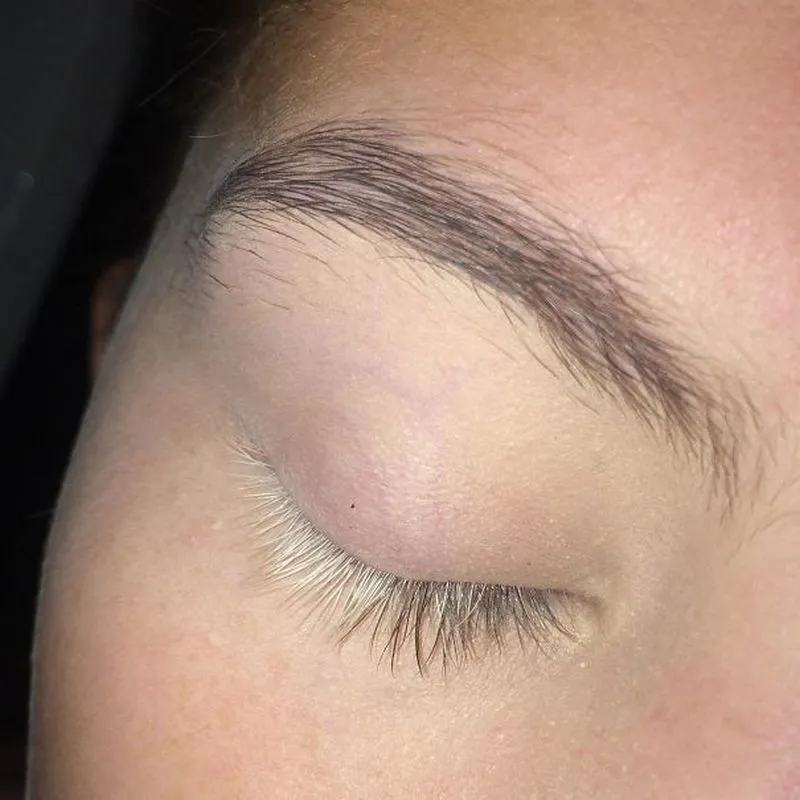 @Inimeitiel-/reddit.com
@Inimeitiel-/reddit.com
What began as a localized phenomenon now affects both the top and bottom lashes, and occasionally, they notice a few white hairs appearing on their eyebrow. This puzzling condition is known as vitiligo, a disorder characterized by the loss of skin pigmentation due to a weakened immune system in specific areas of the body.
38. The Eye is About 1/3 Grey
This striking occurrence exemplifies sectoral heterochromia, a fascinating phenomenon characterized by a variation in the coloration of the iris. Unlike complete heterochromia, where each iris is a distinctly different color, sectoral heterochromia manifests as a specific portion of one iris displaying a contrasting hue compared to the rest of the iris.
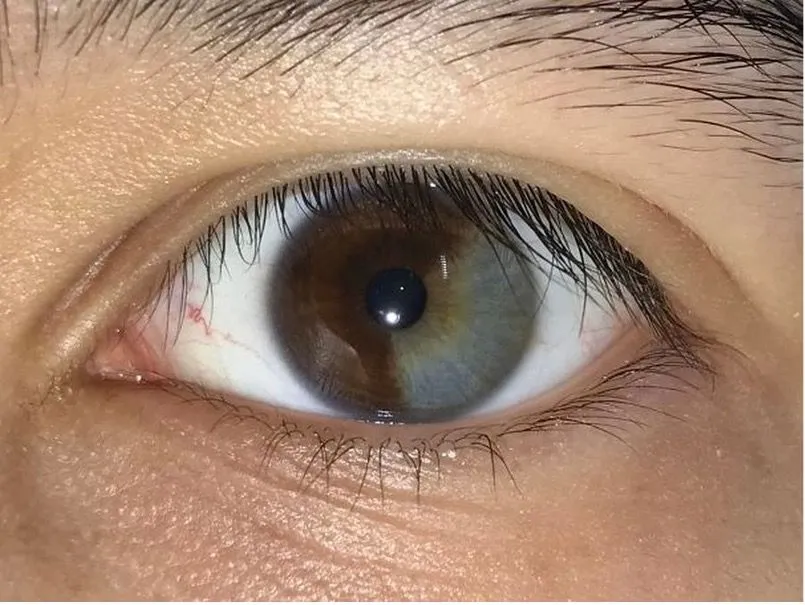 @Nico_LaBras/reddit.com
@Nico_LaBras/reddit.com
Sectoral heterochromia can arise from various factors, including genetic inheritance, genetic mosaicism, chimerism, disease, or injury. In some cases, the trait may be passed down through generations, while in others, it may result from genetic mutations or anomalies during embryonic development.
39. Symmetrical Hair Whorls that Go in Opposite Directions
While it may appear to be a trendy haircut, what you're seeing is a unique hair whorl—a patch of hair that grows in a circular, clockwise, or counterclockwise direction on the scalp. This hair abnormality, although visually intriguing, can present challenges for hairstylists attempting to replicate it.
 @OmongKosong/reddit.com
@OmongKosong/reddit.com
Despite the ongoing research, the exact mechanisms underlying the formation of hair whorls and their potential relationship to handedness remain poorly understood. While genetics likely play a role, other factors such as embryonic development and environmental influences may also contribute to the formation of these unique hair patterns.
40. Freckles on Only Half of the Face
This gentleman's unusual freckle pattern may appear to be a singular rarity, but he's not alone in his distinctive markings. A similar case gained attention back in 2015 when Samantha, a woman from California, appeared on The Doctors seeking an explanation for her unique freckle pattern, which sharply delineated one side of her body from the other.
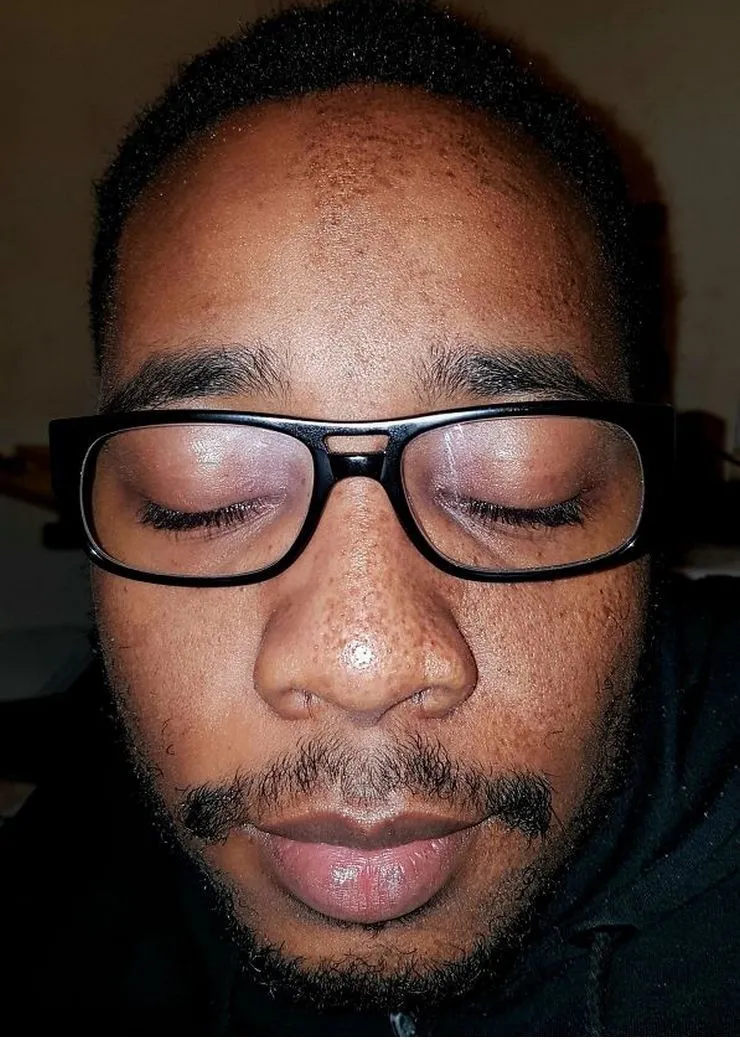 @notsosecrett/reddit.com
@notsosecrett/reddit.com
During the episode, dermatologist Dr. Sonia Batra offered insight into Samantha's condition. As these cells migrate and distribute themselves across the body, the effects of the mutation become apparent, leading to the distinct freckle pattern observed in individuals like Samantha and the gentleman in question.
41. Life with a Scar on the Eye
No, the photo hasn't been edited—what you're seeing is a real scar on the eye, known medically as a macular pucker. The macula, located in the retina of the eye, is responsible for providing sharp vision. When scar tissue forms in this area, it can lead to a condition called macular pucker, characterized by blurred and distorted vision.
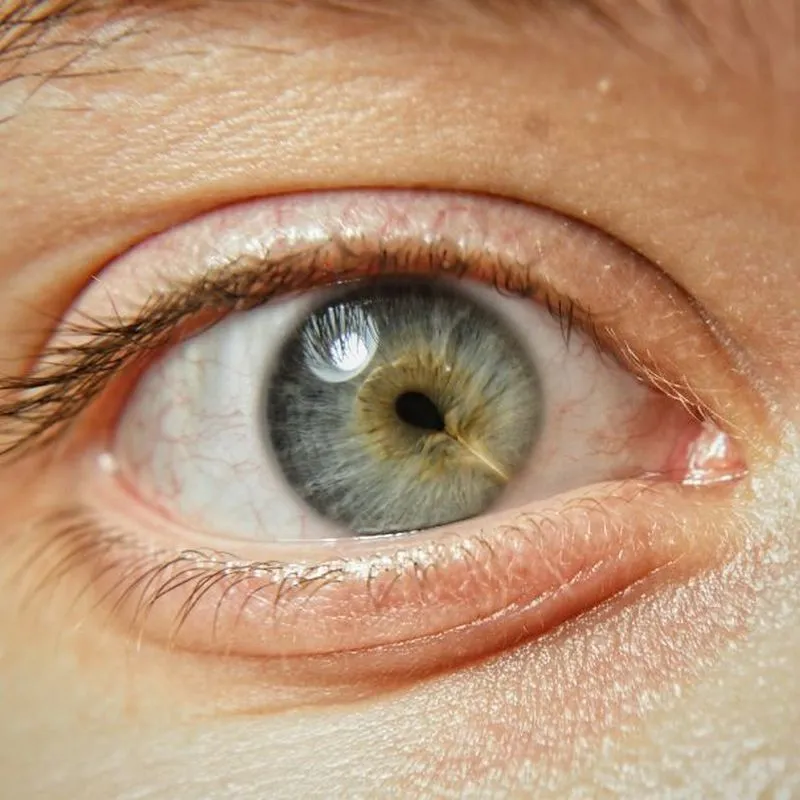 @Spikenw/reddit.com
@Spikenw/reddit.com
Macular puckers typically develop when the vitreous, a gel-like substance inside the eye, detaches from the retina. As this separation occurs, scar tissue may form on the surface of the macula, resulting in the characteristic wrinkling or puckering of the retina.
42. Natural Elf Ears
Stahl's ear, affectionately known as Spock's ear among Star Trek enthusiasts, is a distinctive ear deformity characterized by a pointed shape and an additional cartilage fold. This anomaly is caused by a misshapen cartilage structure within the ear.
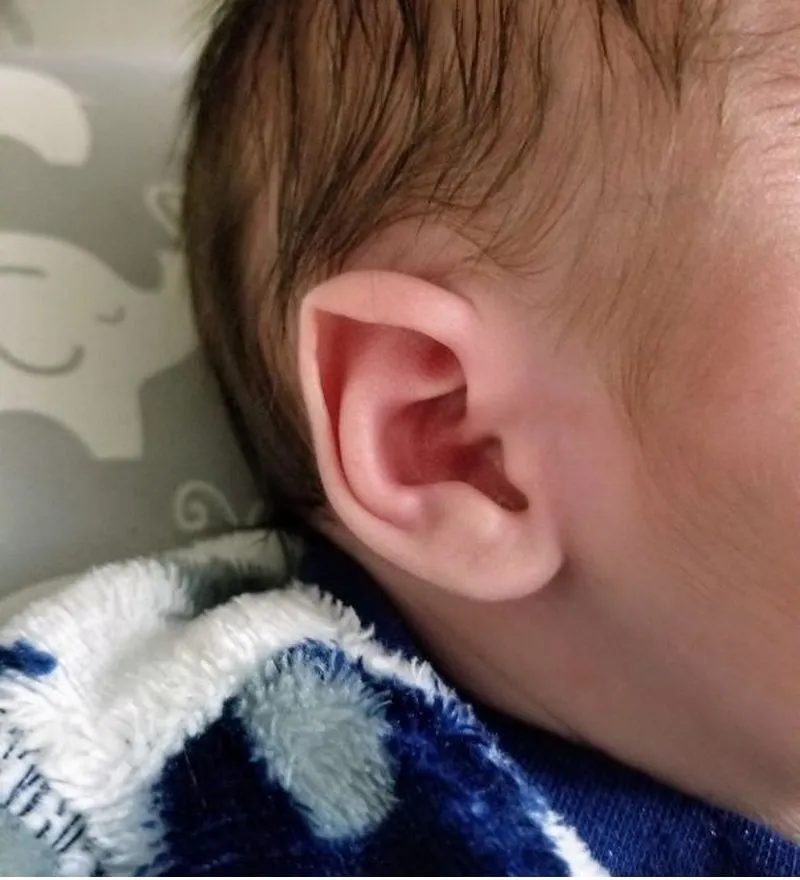 @animaorion/reddit.com
@animaorion/reddit.com
Individuals born with Stahl's ear often have ears that resemble the iconic pointed ears of the fictional character Mr. Spock from the Star Trek series. In addition to the pointed shape, there is typically an extra fold of cartilage, giving the ear a unique and unusual appearance.
43. When a Belly Button Attracts a Lot of Comments
A button belly, often referred to as an umbilical hernia, is a condition where a portion of the intestine or abdominal tissue protrudes through a weakened area in the abdominal wall near the belly button. This creates a visible bulge or "button" appearance around the navel.
 @Swirlxx/reddit.com
@Swirlxx/reddit.com
When describing a button belly resembling a spiral, it might suggest a unique presentation or shape of the protrusion. A spiral-like appearance could indicate that the hernia protrudes in a twisting or coiled pattern, rather than a typical spherical or oval shape.
44. These Toes are Inexplicably Long
This individual likely exhibits a condition known as arachnodactyly, colloquially referred to as "spider fingers." Arachnodactyly is characterized by unusually long and slender fingers and toes, particularly in comparison to the palm and arch of the foot.
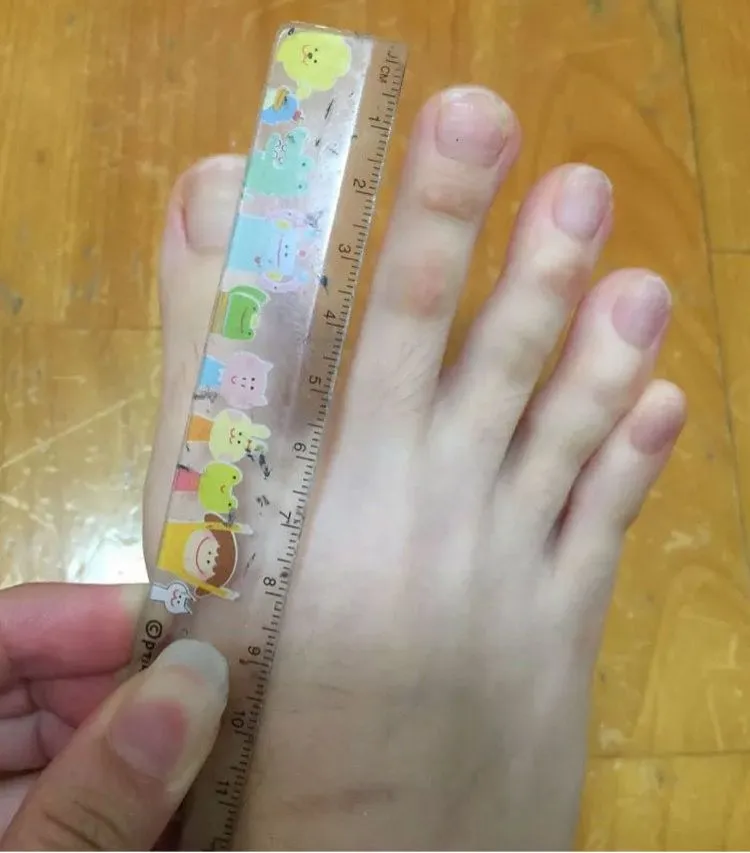 @dcard.tw/reddit.com
@dcard.tw/reddit.com
While some individuals are born with arachnodactyly, others may develop it later in life. For some, this condition may exist in isolation, without any associated health concerns. However, arachnodactyly can also be a feature of certain underlying conditions.
45. A Ring of Brown in the Eyes
A man with a ring of brown in his eyes likely has a unique and intriguing feature known as a limbal ring. The limbal ring is a dark-colored circle that surrounds the iris, providing contrast and definition to the eye's color. The presence of a distinct brown ring within the eye's iris can add depth and intensity to the overall appearance of the eyes.
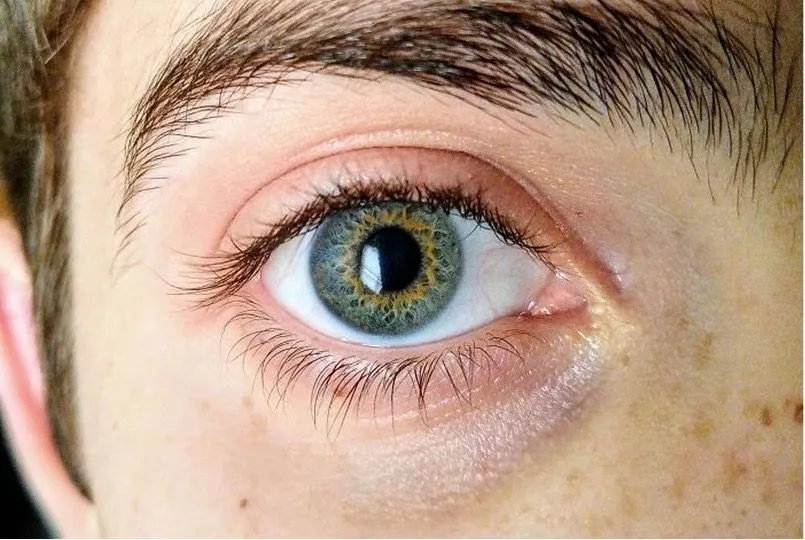 @excynimphica/reddit.com
@excynimphica/reddit.com
It can enhance their visual appeal. Limbal rings are often more pronounced in individuals with lighter eye colors, such as blue or green, where they serve to accentuate the contrast between the iris and the sclera (the white part of the eye).
46. Natural Coloring
The woman born with both blonde and brown hair simultaneously presents a fascinating genetic phenomenon known as hair color chimerism. Chimerism occurs when an individual possesses two distinct sets of genetically different cells, often resulting in noticeable variations in physical characteristics.
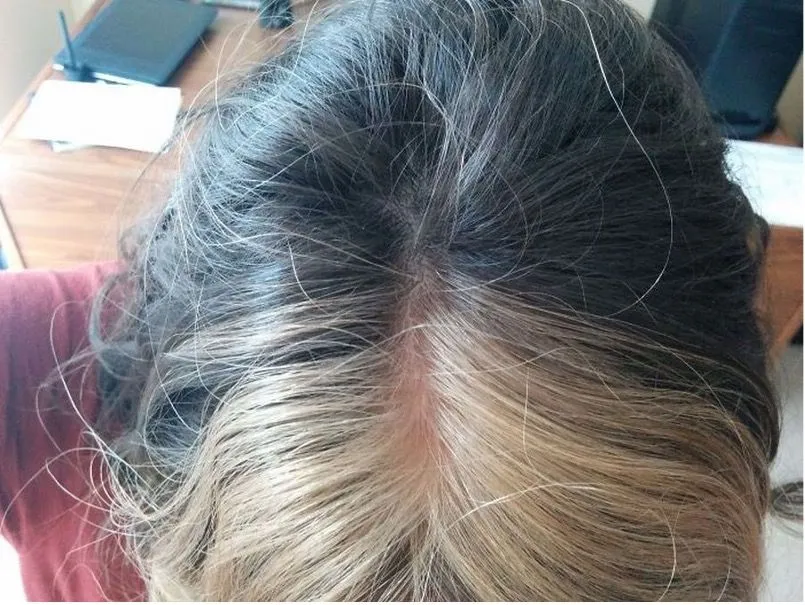 @Mother_of_Bambi/reddit.com
@Mother_of_Bambi/reddit.com
In the case of hair color chimerism, the woman has patches or sections of hair that exhibit different colors due to the presence of distinct genetic populations of hair follicle cells. This unique trait can manifest as strands of both blonde and brown hair growing side by side, creating a visually striking and distinctive appearance.
47. The Extraordinary Pupil of the Eye
When observing a deviation from the typical appearance of the eye, such as an irregular pupil or an abnormality in the iris, it could be indicative of one of two conditions: coloboma or corectopia. Coloboma is characterized by a gap or hole in the eye's structures, most commonly affecting the iris.
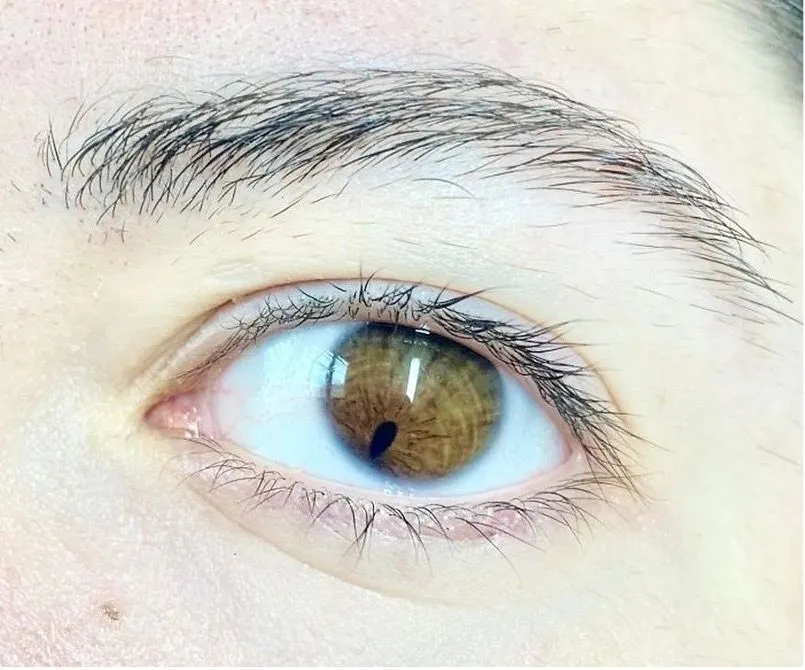 @Nira_kawaii/reddit.com
@Nira_kawaii/reddit.com
This rare condition occurs during fetal development when the tissues of the eye fail to close properly, resulting in a distinct abnormality. In individuals with corectopia, the pupil may appear off-center, giving the eye an asymmetrical or irregular appearance. Some individuals may require surgical intervention.
48. Condition Caused Eyelashes to Grow in Multiple Rows
Distichiasis is a rare congenital condition. Unlike the typical single row of lashes, individuals with distichiasis have an additional row of eyelashes that can vary in number and appearance. This second row of lashes may consist of just a few hairs or a complete set, and they are often thinner, shorter, and lighter in color compared to the primary lashes.
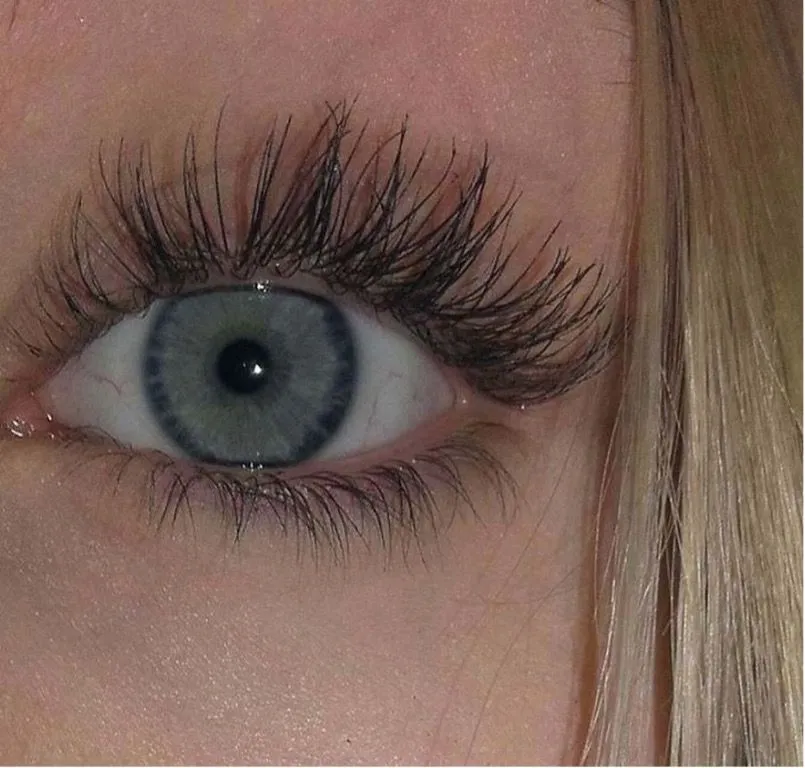 @nisambredl/reddit.com
@nisambredl/reddit.com
While distichiasis most commonly affects all four eyelids, the condition can manifest on just one or both lower lids. The presence of a second row of eyelashes can lead to various symptoms and complications. Some individuals with distichiasis may experience heightened sensitivity to light, irritation of the corneas, or an increased risk of developing conjunctivitis.
49. Rare Congenital Giant Pigmented Nevus
A rare congenital condition known as giant pigmented nevus, or giant furred mole, presents as patches of darker, hairy skin. Typically emerging at birth or within the first year of life, these patches may initially be small but often enlarge as the child grows.
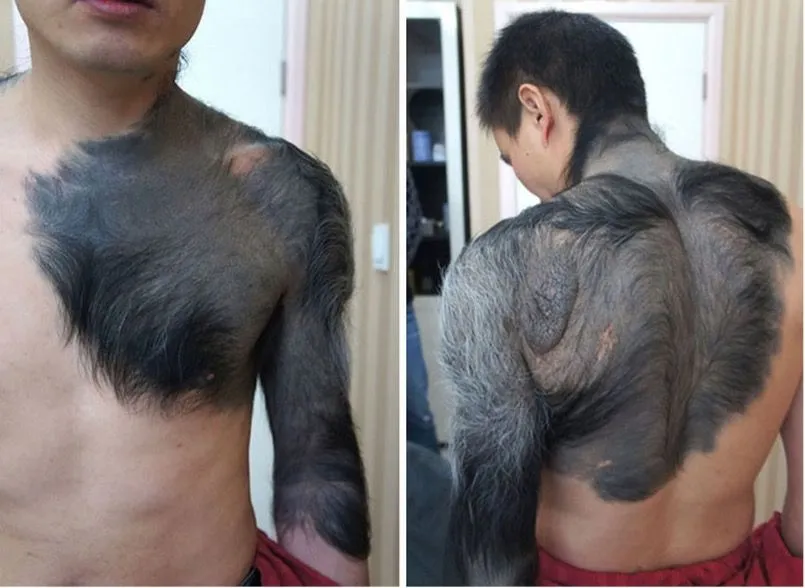 @bobbydigitalFTW/reddit.com
@bobbydigitalFTW/reddit.com
Scientists attribute the development of pigmented nevi to abnormalities in melanocytes, the skin cells responsible for producing melanin, which gives skin its color. In individuals with this condition, melanocytes malfunction, leading to the formation of dark-colored patches of skin.
50. Vitiligo Impacting One Side of a Man's Face
Vitiligo is a chronic condition characterized by the absence of melanin; the pigment responsible for skin coloration. This results in the formation of patches on the skin, typically occurring on areas such as the face, hands, neck, and skin creases.
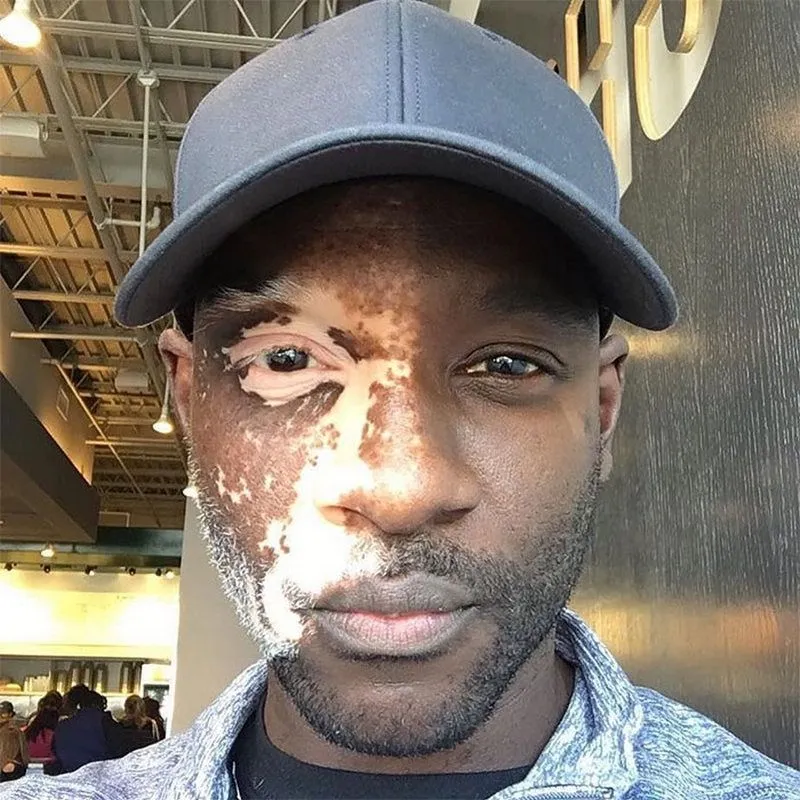 @[delete]/reddit.com
@[delete]/reddit.com
Due to the lack of melanin, these affected areas are more susceptible to sunburn, highlighting the importance of sun protection measures such as using sunscreen with a high SPF factor. Notable individuals who have been open about their experiences with vitiligo include pop singer Michael Jackson and model Winnie Harlow.